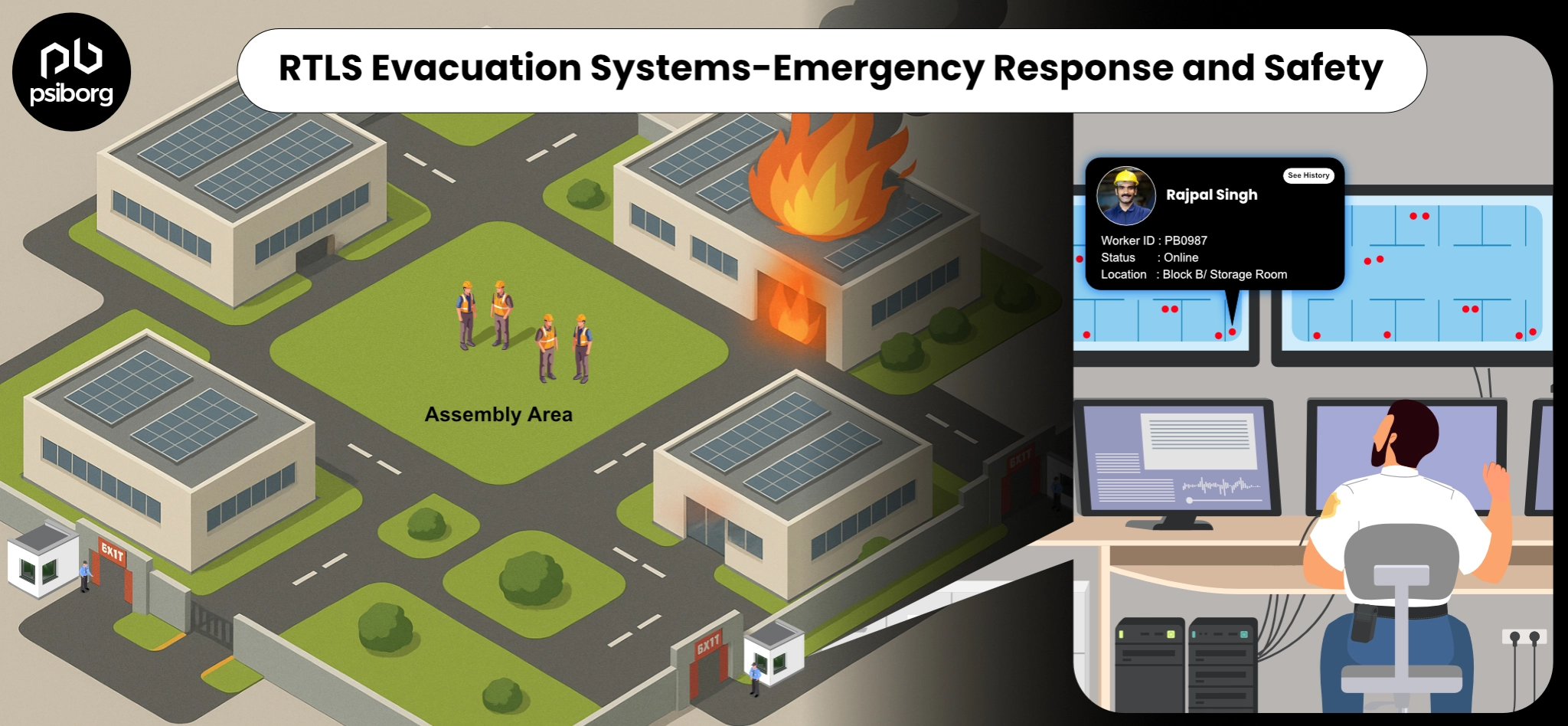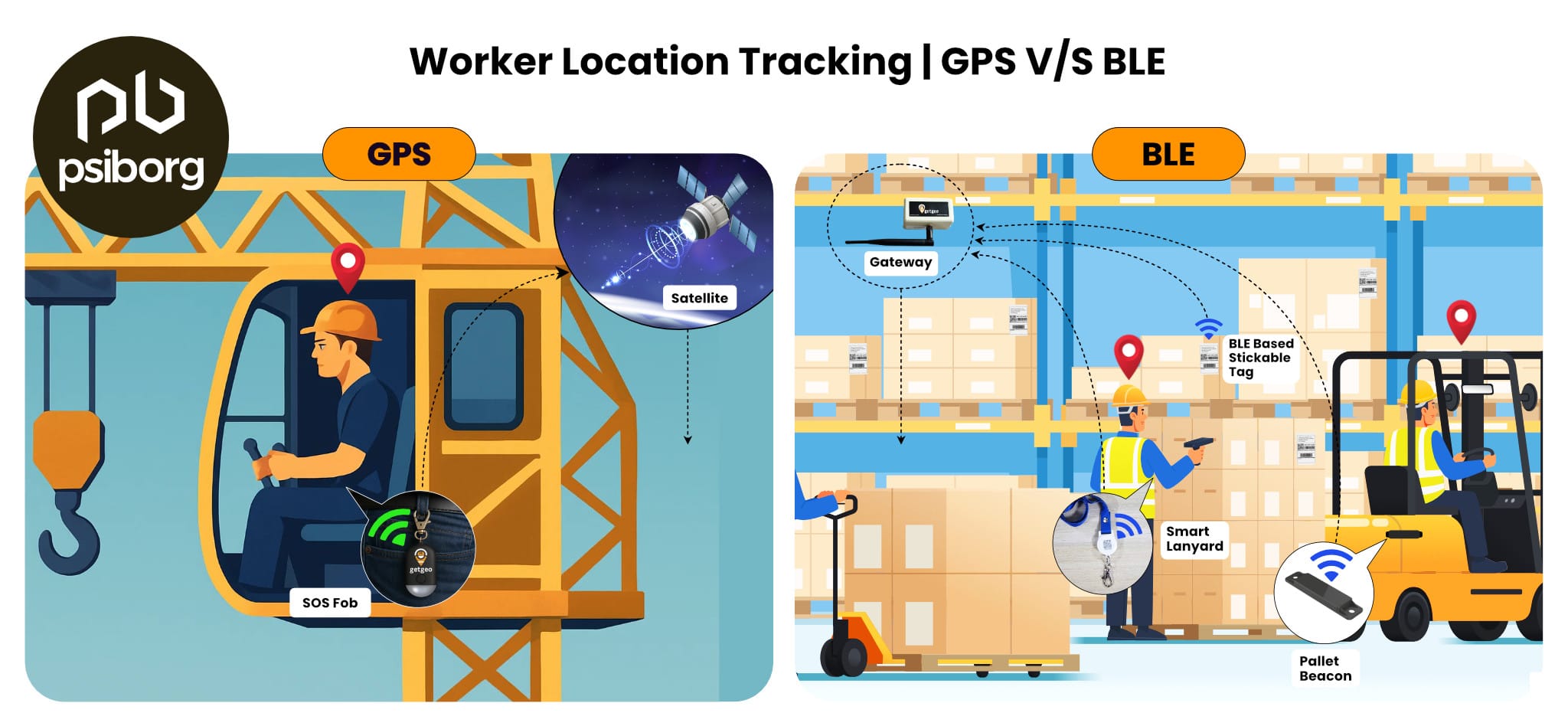Emergencies strike without warning, and every second counts when lives are on the line. Real-Time Location Systems (RTLS) transform evacuation efforts by providing instant visibility of personnel and cutting response times by half.
Studies show delayed evacuations significantly increase injury risk, making RTLS essential for businesses to improve emergency response and compliance. This blog discusses how RTLS evacuation systems help businesses protect lives and optimize safety protocols.

What is an RTLS Evacuation System?
An RTLS (Real-Time Location System) evacuation system is a specialized IoT solution designed to track and manage the location of individuals within a facility during emergency evacuations.
Unlike traditional evacuation methods that rely on manual headcounts or static exit points, an RTLS system provides continuous, automatic, and highly accurate location data in real time.
Core technical components of RTLS evacuation system are:
- BLE-enabled devices: Worn by personnel, these emit signals continuously.
- Fixed Receivers: Strategically installed throughout the building to detect tag signals.
- Location Engine Software: Processes signals to pinpoint the exact position of each tag with room-level accuracy (typically within 1.5 to 3 meters).
- Dashboard & Alerts: Presents real-time data to emergency managers, automates headcounts, and triggers alerts or dynamic evacuation routes.
Building on the technical foundation of RTLS evacuation systems, it’s crucial to understand why businesses must adopt these advanced solutions to ensure safety and regulatory compliance in today’s complex environments.
The Critical Need for Modern Evacuation Systems in Today’s Workplaces
Traditional evacuation procedures struggle to keep pace with the demands of large, dynamic, and high-risk facilities. Several factors make upgrading essential such as:
- Complex Facility Layouts: Modern industrial sites, hospitals, and commercial buildings often have intricate multi-floor layouts with many occupants, making manual headcounts and fixed evacuation routes unreliable.
- Real-Time Challenges: Emergencies evolve quickly; hazards like fires or chemical spills can alter safe pathways instantly, requiring adaptive evacuation management.
- Regulatory Pressures: Increasingly stringent safety standards (e.g., OSHA, NFPA) demand verifiable evacuation procedures and real-time accountability.
- Human Error Risks: Manual tracking and communication lead to delays and inaccuracies, significantly increasing injury or fatality risk.
Now that we understand the importance of modern evacuation systems, let’s explore in detail how RTLS evacuation systems operate to enhance emergency response and safety in real time.
Also, check our Lone Worker safety Monitoring solution.
How Does an RTLS Evacuation System Work?
An RTLS evacuation system functions by continuously monitoring the exact location of personnel within a facility and facilitating efficient, automated evacuations during emergencies. This technology integrates hardware, software, and communication networks to deliver precise, actionable data instantly.
Here’s a detailed step-by-step working of evacuation system:
1. Tracking via Wearable Tags or Badges
Each employee or visitor carries an RTLS tag, which emits signals through Bluetooth Low Energy (BLE).
2. Signal Detection by Fixed Sensors
Multiple receivers installed across the building capture these signals, measuring signal strength and timing to determine the tag’s location.
3. Location Calculation
The system applies techniques like triangulation or time difference of arrival (TDoA) to calculate the position of each tag with room-level accuracy, typically within 1.5 to 3 meters.
4. Real-Time Data Processing
Location data streams into a central software platform which updates IoT dashboards, automates headcounts, and tracks movement dynamically.
5. Automated Alerts and Evacuation Directives
Based on real-time locations and hazard inputs (e.g., fire alarms, smoke detectors), the system sends personalized alerts and dynamically adjusts evacuation routes to avoid dangers.
6. Emergency Responder Support
The system provides first responders with live maps showing locations of people still inside, aiding rescue operations and resource deployment.
Having explored how RTLS evacuation systems operate, it’s important to understand the specific features that make these systems important for emergency safety and operational efficiency.

For tracking and ensuring safety of workforce inside premises , BLE is used , and for outdoors Lone worker tracking devices are used.
Key RTLS Features That Enhance Safety and Emergency Efficiency
RTLS evacuation systems combine advanced sensing technologies and intelligent software capabilities designed to optimize emergency response.
Below are some important features of RTLS evacuation system that improves safety and emergency efficiency:
1. High-Precision Location Tracking
- Provides room-level accuracy, enabling precise identification of occupant locations even in complex buildings. Utilizes Bluetooth Low Energy (BLE) for consistent tracking.
2. Automated Real-Time Headcounts
- Continuously monitors personnel presence, eliminating errors common in manual headcounts.
- Provides instant verification of evacuees and alerts for missing individuals.
3. Dynamic Evacuation Route Guidance
- Adjusts evacuation pathways in real time based on hazards like fire, smoke, or blocked exits.
- Uses geo-fencing to direct occupants away from danger zones safely.
4. Integration with Safety and Facility Systems
- Seamlessly connects with fire alarms, public address systems, and access control for coordinated emergency responses.
- Enables automated alerts and broadcasts to specific zones or individuals.
5. Environmental Hazard Monitoring
- Incorporates sensors for smoke, gas, temperature, and other environmental risks.
- Enhances situational awareness for evacuation decisions.
6. Two-Way Communication Capabilities
- Supports communication between evacuees and emergency responders.
- Facilitates instructions, status updates, and distress signaling during emergencies.
Let’s examine how these solutions are customized to address the specific safety needs across various industries.
Industry-Specific Applications of RTLS Evacuation Systems for Staff Protection
RTLS evacuation systems provide customized safety benefits that align with the unique operational challenges of different sectors. Understanding these applications helps organizations deploy effective solutions that maximize protection and compliance.
1. Healthcare
Hospitals need to track both patients and staff seamlessly, especially in emergencies. RTLS ensures no patient is left unattended during evacuations by providing instant visibility. It also helps meet strict compliance with health safety regulations and sends alerts if critical zones like infectious wards are compromised.
2. Manufacturing & Industrial
From handling heavy machinery to managing hazardous chemicals, factories pose unique dangers. RTLS tracks workers in risky zones automatically, replacing error-prone manual counts. It dynamically reroutes employees away from fire, gas leaks, or equipment failures, reducing injury risks.
3. Education
Schools face the challenge of counting hundreds of students and staff quickly. RTLS simplifies this by providing real-time headcounts and tracking visitors to ensure everyone’s safety. This tech supports quick, organized evacuations, alleviating panic and confusion.
4. Commercial Offices
Office buildings often house multiple businesses and thousands of workers. RTLS offers facility managers a clear picture of where everyone is, floor by floor. Personalized alerts notify occupants efficiently based on their exact location, improving evacuation coordination.
5. Warehousing & Logistics
Beyond emergencies, RTLS supports daily operations by tracking assets and personnel simultaneously. During evacuations, the system reduces accidents by alerting workers about moving forklifts or vehicles nearby, blending safety with productivity.
Conclusion
Modern emergency preparedness demands more than traditional evacuation plans, RTLS evacuation systems provide the precision, automation, and real-time insights necessary to protect lives and ensure compliance.
By delivering accurate personnel tracking, dynamic evacuation guidance, and seamless integration with safety systems, RTLS evacuation system transforms emergency response into a driven, reliable process.
For businesses serious about safeguarding staff and optimizing safety operations, adopting the RTLS evacuation system is no longer optional but essential.
Make PsiBorg your trusted IoT partner. Our fully integrated RTLS solutions combine hardware and intelligent software tailored to your specific industry needs, ensuring your evacuation systems are fast, accurate, and compliant.
Contact PsiBorg today to customize your evacuation strategy and take a proactive step toward safer workplaces.
FAQs
An RTLS evacuation system uses real-time location technology to track people inside a facility during emergencies. It combines wearable tags, sensors, and software to provide precise location data, enabling faster, safer evacuations and automated headcounts with room-level accuracy.
Yes, RTLS systems seamlessly integrate with fire alarms, access control, public address systems, and emergency communication tools, enhancing existing safety protocols by automating alerts, dynamic route guidance, and incident reporting.
Wearable tags emit signals detected by fixed receivers throughout the building. These signals are processed by software to calculate real-time locations, display dashboard data, automate headcounts, and provide dynamic evacuation instructions based on evolving hazards.
RTLS improves emergency evacuations by delivering instant personnel location data, minimizing manual errors, dynamically adjusting evacuation routes to avoid hazards, and providing rescue teams with live maps to locate and assist personnel effectively.
Healthcare, manufacturing, education, commercial offices, and warehousing benefit significantly from RTLS. Each sector leverages RTLS for precise occupant tracking, dynamic evacuation, compliance adherence, and enhanced safety in complex or hazardous environments.




